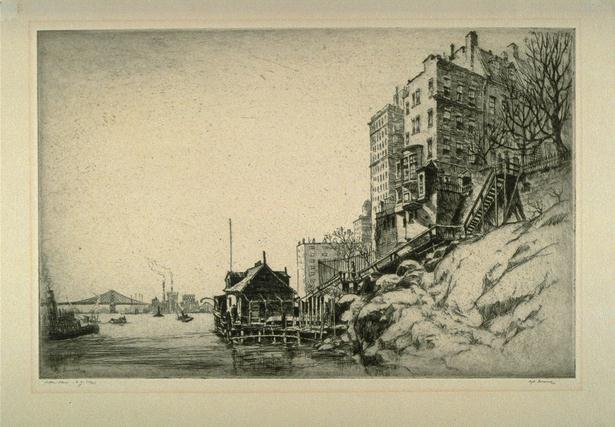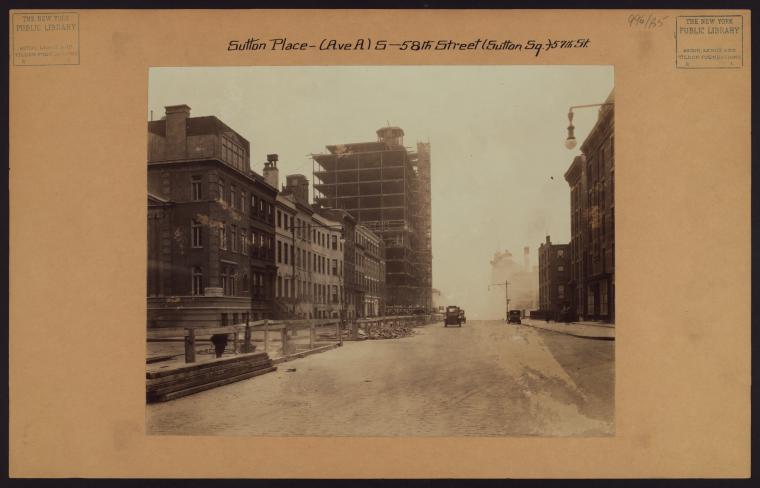 |
New York
Architecture Images- Midtown Sutton Place |
||
|
architect |
various | ||
|
location |
Between York Ave and
FDR Drive, East 53rd to East 59th Streets. |
||
 |
|||
 |
|||
| Image- New York Public Library | |||
|
|
|
||
|
If You're Thinking of Living In/ Sutton
Place; A Riverside Enclave for the Well-to-Do By BRET SENFT Published: June 12, 1994, Sunday BREEZES off the East River cool the gentry on Sutton Place and push the heat waves from the clean, nearly empty street that runs south from the Queensboro Bridge to the exit of the Franklin D. Roosevelt Drive that curves into 53d Street toward First Avenue. Propriety and understatement characterize the quiet enclave bordering midtown. Said Richard Eyens, a resident since 1963: "There's a certain ambiance, a harmony you can definitely feel." Unlike Park or Fifth Avenues, he added, there aren't "10,000 cabs and cars going through it every day, on their way to someplace else; because of its geography, it has its own corner." What is now Sutton Place was once verdant land populated by Reekgawawanck Indians. Early settlers up from Wall Street built country estates along the river from the 1700's to the mid-1800's, when industry -- coal, lumber and brick yards, breweries, cigar manufacturers and coffin factories -- moved in for access to river traffic, and upscale residents moved west to Fifth Avenue mansions. In 1875, Effingham B. Sutton, who had shipped prospecting equipment to San Francisco during the Gold Rush, built brownstones for a residential enclave on the east side of what was then Avenue A between 57th and 58th Street. Sutton Place was born. But the residential dream quickly went bust because of the presence of industry and, by 1909, of the Queensboro Bridge and the New York Steam Corporation, whose stacks towered over Sutton Place at 59th Street. After World War I, Webb & Knapp, the real estate syndicate, enlisted the architects Cross & Cross, among others, to develop town houses with common gardens, alternating with public areas. To draw people east, said the urban historian Val Ginter, "they needed window dressing," and Mrs. William K. Vanderbilt was induced to sell her mansion on Fifth Avenue and move to 1 Sutton Place at 57th Street (now owned by the H.J. Heinz family). J. P. MORGAN'S daughter, Anne, bought the double house next door at No. 3 (now the official residence of the Secretary General of the United Nations). Other society women followed, and development began that lasted to the early 60's as co-ops, condominiums and rentals replaced factories and adjacent workers' tenements. Peter Doelger had built the area's first brewery in the mid-19th century and others followed. But Prohibition hastened their demise, the Doelger family replacing its plant with a parking garage (topped by the Town Tennis Member Club) and four co-ops -- 20 and 36 Sutton Place South, 430 and 440 East 56th Street. At 20 Sutton Place South, said Jack Mara of Morgan New York, a Manhattan real estate agency, a two-bedroom, two-bath currently lists at $335,000 ($1,400 maintenance). At 440 East 56th Street, Penthouse B, a 1,200-square-foot one-bedroom with a 350-square-foot terrace, has an asking price of $375,000 ($1,200 maintenance). Town houses on Riverview Terrace, Sutton Square and the east side of Sutton Place, between 57th and 59th Streets, range in price from, for example, last year's $1.15 million for No. 4 Riverview Terrace (sold four years earlier for $1.925 million) to this year's $2.1 million for No. 17 Sutton Place. In 1989, 16 Sutton Square, once owned by Aristotle Onassis, sold for $8.325 million. The price was so high because the house was built in 1940 (the original having been razed a year earlier for the building of Franklin D. Roosevelt Drive) and remodeled in 1984. The tennis club's two outdoor full courts and practice court sit atop the one-story garage, its stone walls the only remnant of the original brewery. Fees for club membership, by recommendation only, range up to the $3,000 initiation cost for people 40 and over, who pay $2,275 in annual dues. The 357-unit, two-building 60 Sutton Place South is angled as it reaches west along its side streets, giving each apartment at least partial river views. A connecting lobby leads to the underground garage, whose $140-a-month fee is among the lowest in town. Mark Vanderheiden of Vandemar Properties Ltd. lists a renovated three-bedroom two-bath with direct river views at 60 Sutton Place South for $575,000. IN the 47-story, 360-unit Sovereign (420 East 58th Street, completed in 1971), a 1,650-square-foot two-bedroom, two-bath on the 18th floor with river views has an asking price of $595,000. But for all its amenities -- including full services on First Avenue from banks to supermarkets, dry cleaners to florists -- and its proximity to midtown (residents speak of walking to work, or to the Museum of Modern Art, Tiffany's and Bloomingdale's), -- prices and sales of apartments have lagged behind those on Park and Fifth Avenues. "Look at these comparables!" said Marjorie Lichtenstein, a Wm. B. May's broker, handing a visitor listings on Park Avenue (eight rooms, $1.6 million) and 50 Sutton Place South (comparable size, $735,000). In many cases, the Sutton Place apartments are six months on the market, and more, other Wm. B. May brokers said. The reason is that buyers are primarily empty-nesters, as opposed to young people with families, said Barbara Corcoran of the Corcoran Group brokerage. "There's a limited buying audience," she added. Rather than emphasizing the proportion of families without children, Alan Rogers, managing director of the Douglas Elliman Gibbons & Ives brokerage, spoke of "people who are keeping their homes and having a pied-a-terre in New York as well -- what I call a real New Yorker neighborhood." "It's sort of urban living as opposed to family living," he said. One consideration for younger families is the lack of private schools in the area. Such schools are concentrated uptown, in Carnegie Hill, for example, where a large child population simplifies coordinating dates with other children rather than having to cross town, said Alice Platt of the Ambrose-Mar Elia brokerage. "So it's about after-school, too, and weekends -- to have their children near other children," she said. Schools in the immediate Sutton Place area are the k-6 P.S. 59 at 228 East 57th Street and a Montessori School covering nursery to eighth grade at 347 East 55th Street. But there are some young families in Sutton Place. Sarah Schiff, her husband, Carl, director of rheumatology at Maimonides Medical Center in Brooklyn, and their daughters Jessica, 2, and Stephanie, 3 months, live in a large three-bedroom co-op on the 15th floor of 60 Sutton Place, with unobstructed river views. Mrs. Schiff counts six toddlers in the 357-unit complex. THE doormen, heretofore starved for young faces, "give them so much attention," she said. "They know their names, their birthdays, that my daughter loves Tootsie Roll pops." There are several preschools in the area, including Multimedia Preschools at 40 Sutton Place, and one in the Sutton Place Synagogue at 225 East 51st Street. Jessica attends the International Preschool, 330 East 45th Street, twice a week, for which her parents pay $2,500 a year. "A lot of us congregate at Tal Bagel (979 First Avenue at 53d Street) in the morning, because they have minimuffins for the kids," Mrs. Schiff said. For some, one of the attractions of the area is its international name recognition. On a recent Saturday, Wahid Tabani, a three-year Sutton resident who is a stockbroker in midtown, enjoyed the serenity of Sutton Square Park at the end of 58th Street. "It was just a desire, in coming to New York," he said. "Just the awe of living on Sutton Place was something I wanted to fulfill." Sutton Area Community Inc., a 1,600-member civic group known as SAC, was formed in 1977 to address such quality-of-life issues as overdevelopment and traffic. It also subsidizes the city's three vest-pocket parks in the neighborhood with plantings and maintenance through the seasons. The same year SAC was formed, Bridgemarket Associates applied to lease city-owned property in the vaulted space under the Queensboro Bridge between First and York Avenues for a complex of specialty food stores and restaurants that it called Bridgemarket. The application was approved by both the Board of Estimate and SAC, but the project remained dormant until 1987, when the city's Public Development Corporation granted the developers an increase in space from 46,000 to 130,000 square feet by digging into the site. Alarmed at the increase in size, and the implicit concomitant increase in pedestrian and vehicular traffic, SAC filed suit in 1988 over the interpretation of the project's size in the lease approved by the Board of Estimate. (In 1990, the Public Development Corporation tried unsuccessfully to terminate Bridgemarket's lease for defaulting on $600,000 in back rent.) LAST March 24, the Court of Appeals found for the developers, holding that no additional approval beyond that of the Public Development Corporation was necessary. SAC has filed briefs for reargument, but the future of the project remains uncertain and the area is fenced off and strewn with debris. The area abounds in first-class restaurants featuring continental cuisine. But among the casual favorites are Billy's -- the 124-year-old mainstay at 948 First Avenue -- and Neary's, 358 East 57th Street. Neary's opened 27 years ago on St. Patrick's Day. A visitor was recently met at the door by 25-year-old Una Neary, eldest daughter of the owner, Jimmy Neary, who was moonlighting from her day job as a bank regulator. Opposite the bar are framed book covers: mysteries by Mary Higgins Clark (whose fictional characters eat at Neary's) and "Angel," by Barbara Taylor Bradford. A frequent customer, Mrs. Bradford was at a corner table the other evening with her husband, Robert, a film producer. They live on Sutton Place. Asked to comment on life there, Mrs. Bradford said, "It's . . . er . . . wonderful." After the couple left, Ms. Neary leaned toward her visitor. "She's very quiet, very low-key, she said. "Like the neighborhood." Published: 06 - 12 - 1994 , Late Edition - Final , Section 10 , Column 2 , Page 5 Copyright New York Times. |
|||